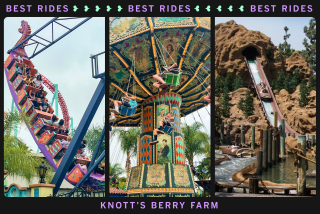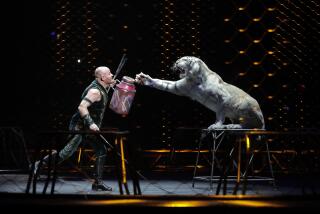Spin Doctors
- Share via
BURBANK — When the jumping lion made his skin crawl, Brad Perron recognized the depth of his antique carousel infatuation.
He was in Portland, Ore., looking at a carousel--a modern one with fiberglass animals, too many lights, too much plastic. Attached to a pole, rising up and down, was the lion. “There was the huge lion that was designed to stand, and they’d put it on a jumping pole. And no one cared . . . even though it was totally wrong,” Perron said. “It almost made me sick, and that’s when I knew I was in too deep.”
Antique carousels have, in fact, worked their seductive magic on the entire Perron family. Based in Hood River, about 60 miles east of Portland, the Perrons have launched a one-family crusade against the extinction of hand-carved, wooden carousels. With obsessive dedication worthy of any pet-rescue operation, they buy and restore whole carousels and then find safe places to operate them.
Their latest placement is an 1895 carousel by famed carver Charles Looff, which was at the former Pacific Ocean Park in Santa Monica in the 1950s. Its new home is in the center court of Media City Center mall in Burbank. The site has everything the Perrons could want: a roof overhead, 24-hour security, and a steady stream of children whose eyes light up with every spin. After a monthlong installation, the carousel carried its first Burbank passengers May 10. Families lined up for the $1.50 ride, keeping it 75% full both days that weekend.
These early signs of success are reassuring to Brad Perron, who initially wanted to put a smaller--and less expensive--carousel in Burbank. But when he saw the mall’s three-story circular center court, he changed his mind.
“We walked in on the second level,” he said. “I looked down, and looked up, and I was just blown away. I knew which machine it had to be.” Indeed, it appears as if the mall was built to fit around the 60-foot-diameter carousel. From the upper levels, shoppers can peer down and see the machine at work. “The biggest problem was I had to talk my mother out of the machine. Every time I take a carousel out of Hood River, it’s like losing one of her children.”
*
The Looff Carousel was a particularly hard one to say goodbye to, said Carol Perron. It was one of the first ones the family bought, and she named--and painted--all the 56 animals on it when they restored it, except for one left unpainted to show how the figures are constructed. “I’d much rather paint a horse than anything on canvas,” she said. “When the paint gets on them, they gain their personality. They come alive.”
There also are several uncommon carousel creatures on the Burbank machine, including a dragon, a goat, a small dog, a trio of giraffes and a bear. All the pieces are covered with 12 coats of clear varnish to protect them from the eroding effects of constant use.
It was Carol Perron’s desire to own a carousel horse that led to the family fixation. She kept asking her husband, Duane, a bank executive, to buy one. And he kept insisting they were too expensive. Finally, in 1974, after watching the prices on the horses rise and rise, the Perrons bought a set of 38 small horses and then started restoring them, trading them, selling them.
That didn’t last long. As their sons, Brad and Carl, grew from preschoolers to young men, the Perrons quickly moved into buying whole carousels and restoring them so their history and artistry could be appreciated by millions.
Carousels first appeared in the Byzantine Empire, where they were used for entertainment and to train knights, who would try to spear hanging rings. In the late 1870s, trolley companies in the United States started buying carousels to put at the end of the line to lure more evening and weekend passengers.
By the turn of the century, there were about 10 major American carvers--including Looff, C.W. Parker, M.C. Illions, and Gustav Dentzel--with carousel-building companies, mainly in the Northeast. They recruited cabinet and furniture carvers from Europe, and by all accounts the U.S.-made animals soon surpassed their European counterparts in size and elaborate detail.
By 1925, an estimated 5,000 carousels dotted the American landscape, some stationary, others traveling to county fairs. They got plenty of wear and tear from passengers--mostly adults--and weather. But it was the Great Depression that struck the most damaging blow. Amusement park visits were a luxury, and when money got tight the carousels were neglected. Some were dismantled, the parts tossed into barns. More often, the boards and horses were piled up and burned. Later on, wooden horses were supplanted by aluminum and fiberglass ones.
Today, there are only 142 historic carousels left in the world--most of them in America--compared to 220 a decade ago. The Perrons own 20, eight operating and 12 waiting to be restored.
In recent decades, the threat to wooden carousels is the value of their individual animals to collectors. Though prices peaked in the late 1980s, a $10,000 horse is still considered cheap. Rare animals can cost four to five times that. In 1992, a merry-go-round St. Bernard drew a record-breaking $174,900 at auction.
In a sense, this makes the Perrons’ collection of more than 700 carousel animals highly valuable. But it also puts many intact carousels financially out of reach. At auction, bids are taken on all the animals. Those prices are added up, raised by 10%, and then bidding begins for the whole machine. The number of animals per machine can range from a couple of dozen on a small, indoor carousel to, for example, the 68 jumping horses on the Edward Spillman model in Griffith Park.
*
In carousel circles, there are two schools of thought on what should be done with these historic machines--and groups advocating both philosophies. The National Carousel Assn. supports preserving complete wooden carousels and keeping them running for public enjoyment. The American Carousel Society, which has its convention in Long Beach next weekend, focuses on collectors of individual animals.
Marianne Stevens, who founded both groups but currently serves as director for the ACS, said it’s not a black-and-white issue. “I personally would like to see all of them that can be operated, operated,” she said. “But I hate to see the wood showing through . . . and if there is piece broken off, and they don’t put it back. But mainly the big parks now have risen to the point that they cherish their old carousels.”
Though the Perrons got into the game late, Stevens said, “I have to applaud their efforts in buying and trying to save them.”
There was a time, though, when Brad Perron and his brother, Carl--now an architect--didn’t really appreciate the carousels. Brad was about 5 when the horses and giraffes started to appear in every room in their house. But by high school, the boys didn’t understand why their father was sinking all his money into merry-go-rounds.
“Dad could sell one animal and buy a Mercedes, but they were driving old junker cars because they wouldn’t sell” the animals, Brad Perron said. “We hated these things until we were in our early 20s, when we started realizing what a significant thing has been done by our mother and father. There are over 700 animals in our collection and that’s unique in all the world.”
Carol and Duane Perron were struggling to reestablish a carousel museum in Portland--they lost a location to a developer--when they invited Brad, a successful mortgage banker at age 28, to join the family business. “They said, ‘Look, you can do anything you want with this collection, but you can’t sell it. But you can do anything you want to make an income with it,’ ” the son recalled.
*
So he set about finding homes for the restored carousels where they could start to pay their own way. Historic Carousels Inc., their business, now has eight of the machines operating, including ones in Puente Hills Mall, Parkway Plaza in El Cajon, and South Bay Pavilion in Carson. He currently is negotiating to put another one in Santa Barbara next year, as the family continues to look for a site for an international carousel museum.
Though the family maintains ownership, the Perrons hope each community adopts the carousel and takes pride in it. As long as people ride, it’ll keep running, and the Perrons will be able to buy and restore another historic carousel. In fact, the Perrons pay property owners such as the Media City Center a percentage of the admissions revenues to display their machines. Much of their cut, like the continual revolving of their carousels, is reinvested in maintenance and new restoration projects.
Still, the banker in Brad Perron knows they could make more money by selling the animals and just investing the cash. But that wouldn’t save the carousels. It couldn’t delight children as they choose a jumper to ride. It would never inspire the pure joy of that first revolution.
“That’s been the incentive,” said Brad Perron, “knowing I’m putting a million smiles a year on people’s faces.”
More to Read
Sign up for Essential California
The most important California stories and recommendations in your inbox every morning.
You may occasionally receive promotional content from the Los Angeles Times.









